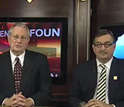News Release 10-089
New Survey Facilitates Better U.S. Business Competition in Global Economy
U.S companies grossed nearly $11 trillion in worldwide sales and spent $330 billion on R&D in 2008

New business R&D survey replaces a previous industry survey that had been conducted since 1953.
May 26, 2010
View a webcast featuring NSF Director Arden Bement and Deputy Director of the U.S. Census Bureau Tom Mesenbourg.
This material is available primarily for archival purposes. Telephone numbers or other contact information may be out of date; please see current contact information at media contacts.
Companies located in the United States reported worldwide sales of $11 trillion in calendar year 2008 and spent $330 billion on research and development (R&D). Nearly $234 billion of the R&D expense was for R&D conducted in company facilities located in the United States. This is according to new figures from the National Science Foundation's first ever Business R&D and Innovation Survey (BRDIS) developed jointly with the U.S. Census Bureau.
The new survey results from a 2004 recommendation to redesign NSF's previous industry R&D audit instrument called the Survey of Industrial Research and Development. The National Academies' Committee on National Statistics made the recommendation to cope with dramatic, fast-moving changes in the way R&D has been conducted during the last 50 years.
Conducted as a full-scale pilot, the BRDIS replaces the previous survey, which had been carried out every year since 1953. "Our world has changed a lot since 1953 and so has the way R&D is conducted," said Arden Bement, director of the National Science Foundation. "This new survey addresses those changes."
Specifically, it will allow policymakers and industry officials to gain information about worldwide R&D expenses, R&D employee headcount by occupation category, R&D expenses by detailed business segments, and share of R&D devoted to new business areas and new science or technology activities. None of these capabilities existed with the previous survey, which solely focused on domestic R&D and asked few questions about the makeup of industry employees or a company's ability to innovate technologically in the competitive global marketplace.
According to initial BRDIS survey results, companies with R&D activity reported that 68 percent of their worldwide sales came from domestic business operations. The pharmaceuticals and medicines industry reported that 67 percent of their worldwide sales came from domestic operations.
Other industries reported similarly high domestic-to-worldwide sales ratios. Data from scientific R&D services industries revealed that 85 percent of their sales came from domestic operations; computer system design and related services reported 79 percent; aerospace products and parts reported 74 percent; motor vehicles, trailers, and parts reported 62 percent; software publishers reported 58 percent and semiconductor and electronic components reported 53 percent.
In other statistics on sales, BRDIS survey results found that worldwide R&D expense and worldwide R&D costs funded by companies with 5-499 employees accounted for $1 trillion of the total worldwide sales. These companies had worldwide R&D expenses of $64 billion, or 19 percent, of the total expenses for R&D worldwide. Small businesses also performed $63 billion worth of business R&D in the United States and $5 billion abroad. They paid others $11 billion to perform R&D.
The data was taken from a representative sample of about 40,000 U.S.-owned businesses and U.S. affiliates of majority-owning companies located outside the United States that are carrying out research and development activities. Surveys were mailed to companies in January 2009.
Data from the survey can be found on NSF's website. These data are preliminary; final statistics from the pilot will be available in early 2011. Two additional reports scheduled for release in 2010 will present preliminary 2008 statistics on worldwide and domestic employment, including R&D employment and innovation, respectively.
-NSF-
-
View Video
Arden Bement and Tom Mesenbourg discuss the new Business R&D and Innovation Survey.
Credit and Larger Version
Media Contacts
Bobbie Mixon, NSF, (703) 292-8485, email: bmixon@nsf.gov
Program Contacts
Raymond M. Wolfe, NSF, (703) 292-7789, email: rwolfe@nsf.gov
John E. Jankowski, NSF, (703) 292-7781, email: jjankows@nsf.gov
The U.S. National Science Foundation propels the nation forward by advancing fundamental research in all fields of science and engineering. NSF supports research and people by providing facilities, instruments and funding to support their ingenuity and sustain the U.S. as a global leader in research and innovation. With a fiscal year 2023 budget of $9.5 billion, NSF funds reach all 50 states through grants to nearly 2,000 colleges, universities and institutions. Each year, NSF receives more than 40,000 competitive proposals and makes about 11,000 new awards. Those awards include support for cooperative research with industry, Arctic and Antarctic research and operations, and U.S. participation in international scientific efforts.
Connect with us online
NSF website: nsf.gov
NSF News: nsf.gov/news
For News Media: nsf.gov/news/newsroom
Statistics: nsf.gov/statistics/
Awards database: nsf.gov/awardsearch/
Follow us on social
Twitter: twitter.com/NSF
Facebook: facebook.com/US.NSF
Instagram: instagram.com/nsfgov



